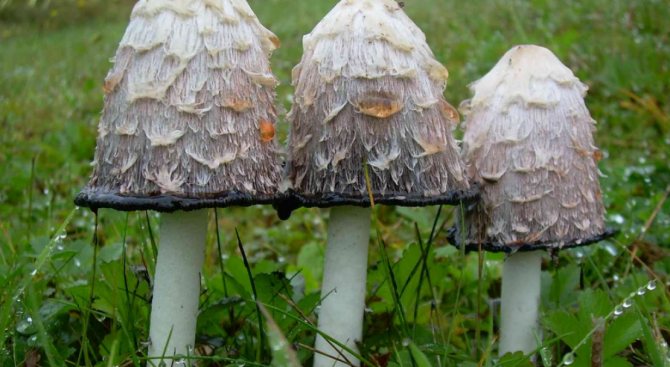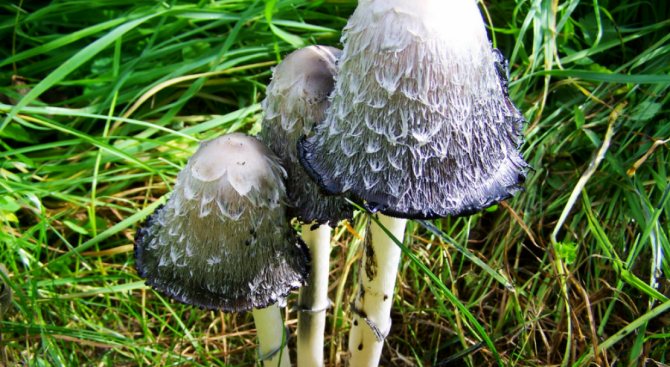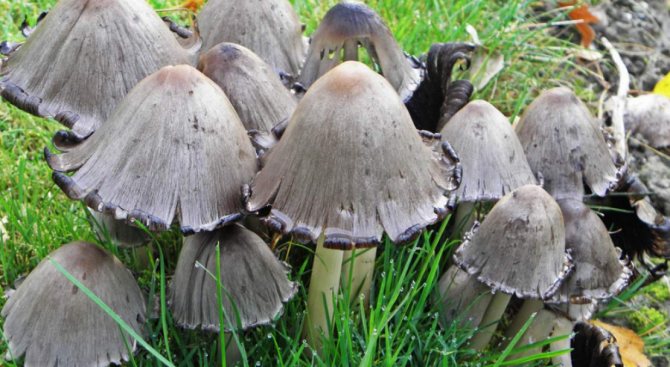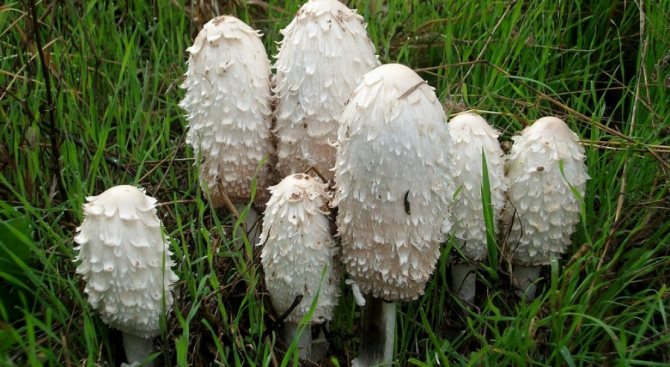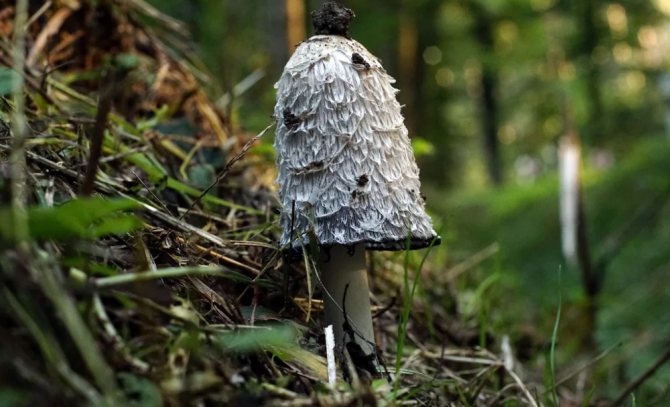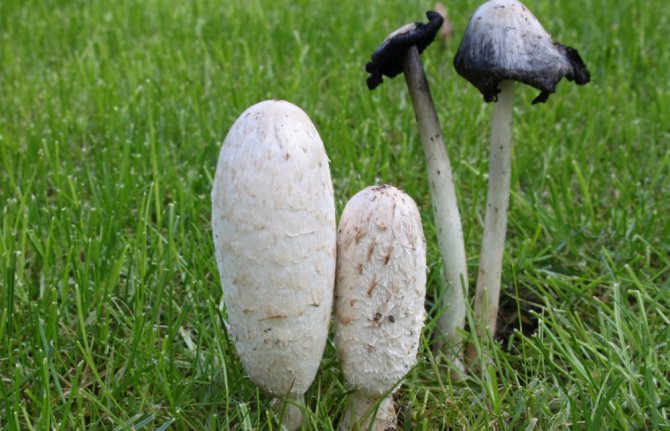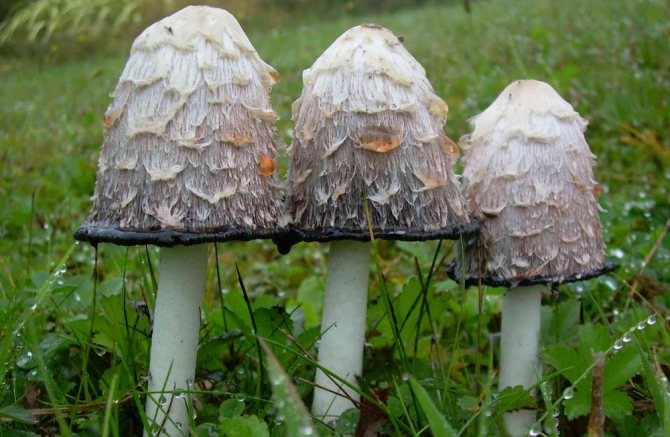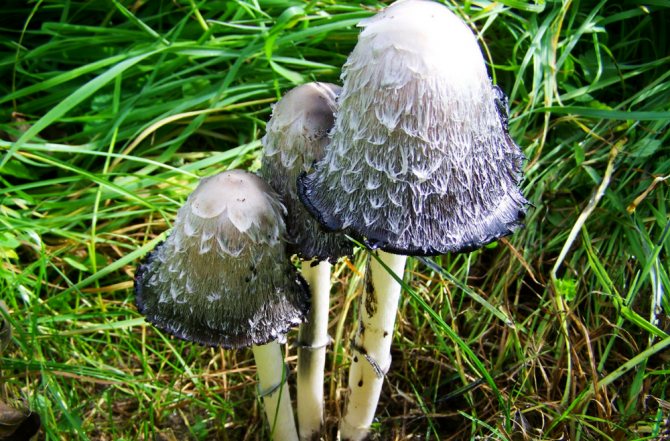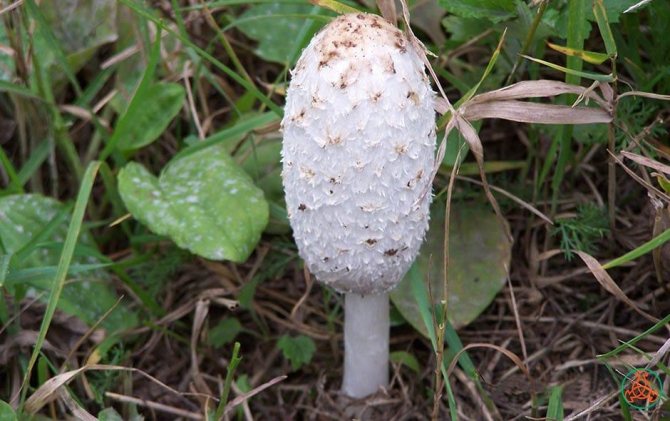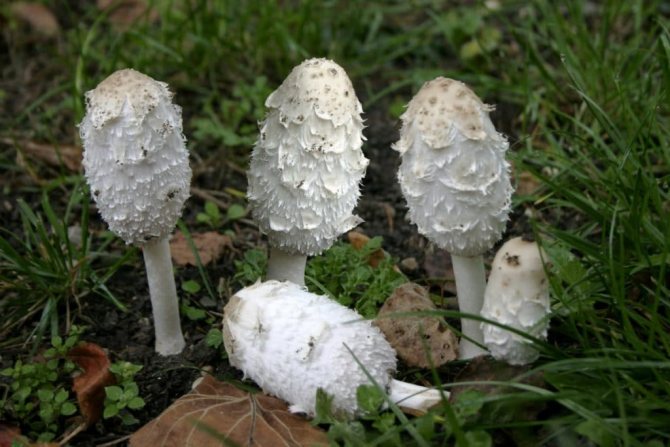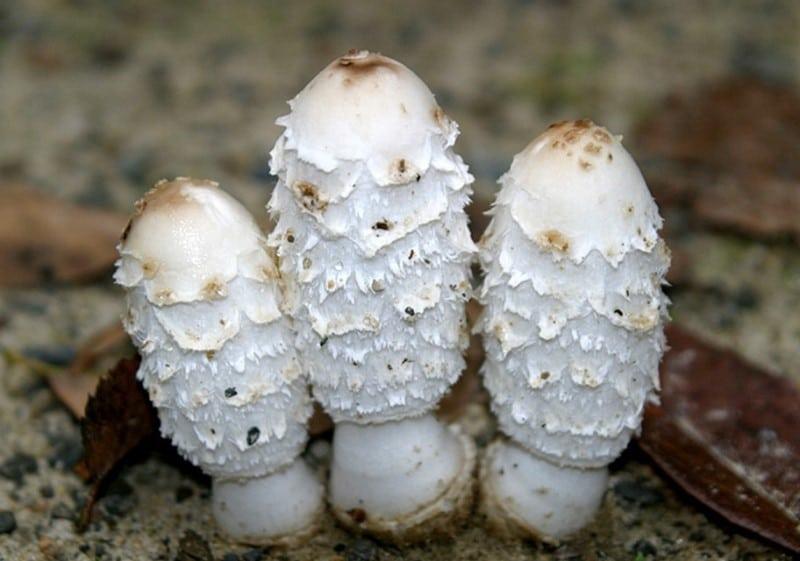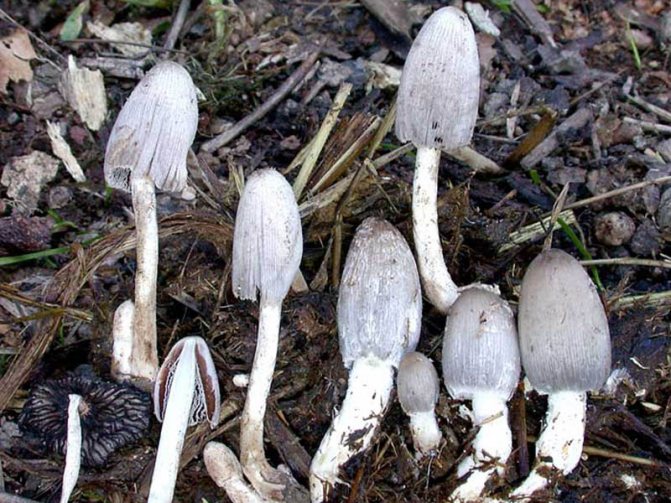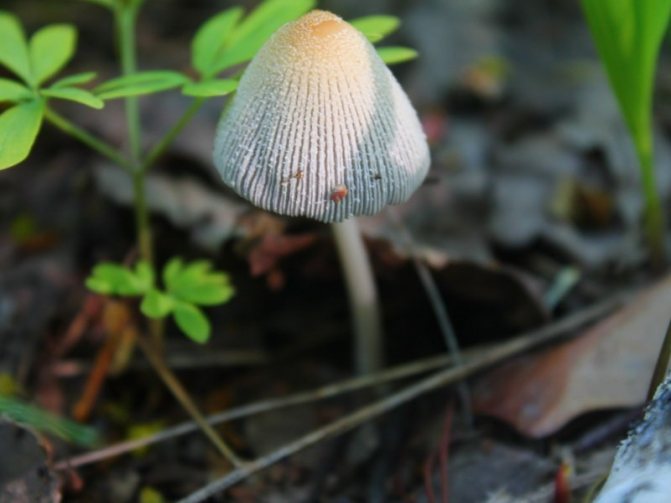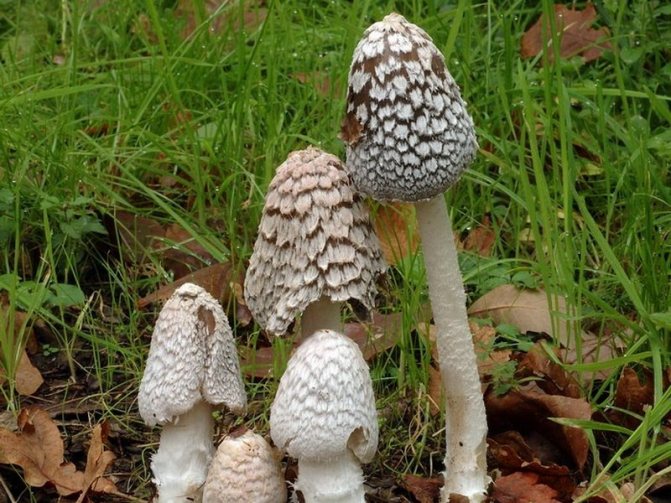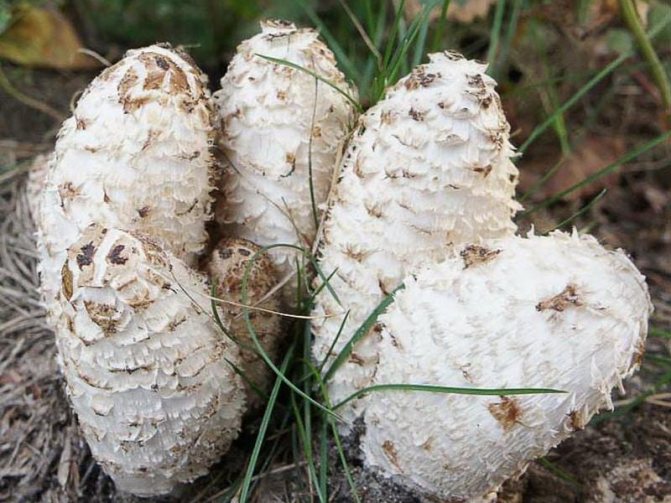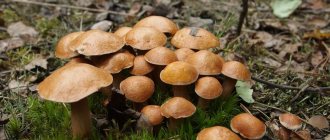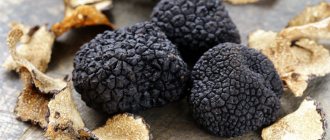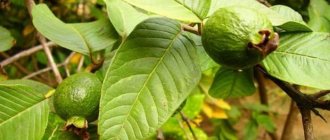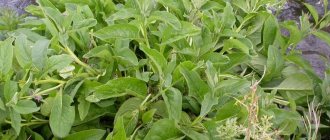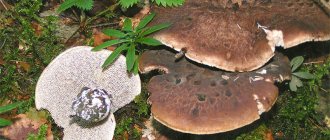Mushrooms
0
1193
Article rating
The dung beetle mushroom is popularly nicknamed "filthy". But this name is not entirely true - in fact, this mushroom is considered a delicacy. It belongs to the genus Dung, the order Agaricaceae, or Lamellar mushrooms. Another name is koprinus. Previously, this genus of mushrooms belonged to the Dung family, but now the species are assigned to different families (Champignon, Psatirella, etc.), because carried out at the end of the twentieth century. Phylogenetic studies have shown the heterogeneity of different dung beetle species.
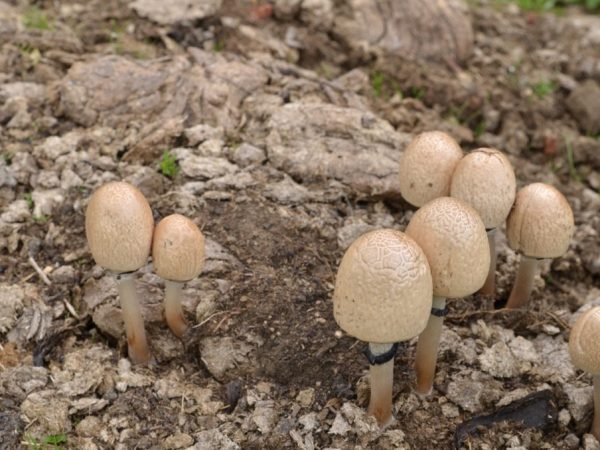
Features of the mushroom variety Dung
Mycological characteristics
All varieties of lamellar dung beetles have common parameters in the description.
- Fruit body. Sizes are from small to medium, in rare cases large specimens are found.
- Hat. The shape is bell-shaped, conical or convex, less often - flat, prostrate. The surface is smooth, bare, but more often covered with a scaly or flaky layer. Can be up to 10 cm in diameter
- Pulp. The structure is fleshy, almost absent in some varieties.
- Mushroom leg. The location is central. Cylindrical shape with elongation. The structure is fibrous. The surface is smooth. The internal cavity is not filled.
- Hymenophore. Formed by thin, often planted plates. Its color in young specimens is white or cream; as it ripens, it becomes black.
- Velum. Residual fragments of bedspreads are present on the cap in the form of small flakes or scales, or are completely absent. In some mushrooms, a narrow membranous ring remains on the stem, less often the remains of a volva.
- Reproduction. Propagated by spores. The color of the spore powder is black.
Most members of the genus are capable of self-digestion of the cells of the hymenophore plates and the cap as a whole after the end of spore maturation (autolysis or autolysis).
Self-dissolution of tissues occurs due to their own hydrolytic enzymes, which have a destructive effect on the structural molecules of cells.
():
Dung bearers have interesting features:
- So, among the mushrooms, they can be considered ephemeral. They grow and ripen so quickly that not a single species of this kingdom is able to compete with them in this. The life of small species is extremely short. Having appeared in the evening, by the morning their fruiting bodies already disappear.
- After the ripening of the spores, the fruiting body self-destructs and transforms it into a liquid black mass with many spores. This phenomenon in science is called autolysis or autolysis.
- Ripening of basidiospores begins from the lower edge of the cap, and it is from here that the autolysis process begins. As a result, the cap is "shortened" from the bottom up.
In a number of countries "cooprinus ink" is used, consisting of a suspension of fungal spores in water, gum arabic, and some other substances. They are used for photo retouching and other purposes. You can determine the authenticity of a text or drawing by the presence of disputes in them. Therefore, dung beetles received a second name - ink mushrooms.
Procurement of medicinal raw materials
For medicinal purposes, fruiting bodies are most often used in powder form. The processing of the harvested fruiting bodies must be carried out as soon as possible, which is due to the susceptibility of such mushrooms to the process of natural autolysis.Without processing, freshly harvested or frozen fruit bodies darken strongly within two or three hours and quickly decay.
Only young fruiting bodies, which are characterized by the presence of unopened caps and white plates, are needed to collect for the preparation of medicinal raw materials. It is only necessary to collect mushroom caps, and the presence of a pinkish, yellow or grayish tint on the plates indicates the unsuitability of the dung beetle for harvesting.
Drying of the collected caps is carried out in a pan... Pre-cleaned fruit bodies must be thoroughly rinsed and dried, and then put in a pan. Frying is carried out over low heat, with occasional stirring without oil. During the drying process, a fairly large amount of liquid is released, so the drying process takes a long time. Fully dried mushrooms need to be ground to a powdery state using a coffee grinder or kitchen blender. This powder can also be used as an aromatic spice.


When coprinus enters the body of a person who has taken alcohol, the active substance of coprin interacts rather quickly and the oxidation process takes place with the formation of acetaldehyde
Varieties
The type genus of dung beetles, according to the mycological data of the check-list from 2010, has about 25 species, but more often only a few fungi are found in nature. We will consider them.
- Grey. Conditionally edible. Height up to 20 cm. The diameter of the cap is up to 5 cm. The shape is initially ovoid, then bell-shaped. In the central part there is a black seal, therefore it has a different name - ink. Young specimens have a "shaggy" ring in the middle part of the leg, which disappears as they mature. Growing places - grass vegetation, tree stumps, fertilized soils, roadsides of city roads.
- Absent-minded. Height up to 3 cm. The diameter of the cap is up to 1.5 cm. Bell-shaped, formed by folds. The color is yellow with brown, subsequently changing to gray. The surface is scaly, glossy. The structure of the leg is fragile. In young specimens, the hymenophore plates are light, grow together with each other, in old specimens they change color to black. The pulp is too thin, without the characteristic smell and taste. Due to its small size and small amount of pulp, it is considered inedible. Growing places - rotten wood.
- Folded. No data on edibility. Height 10 cm. The diameter of the cap is up to 3 cm. The shape of young specimens is closed, elongated, conical; as it matures, the description becomes similar to a half-open umbrella. There is a dark fragment in the central part. Sometimes the plates of the hymenophore grow together, forming a ring-shaped thickening at the top around the leg - a collarium. Places of growth - meadow glades and roadsides of city roads.
- Variegated (magpie, woodpecker). Inedible. Height up to 30 cm. The diameter of the cap is up to 10 cm. The shape is cylindrical or conical in young specimens and wide bell-shaped in adult specimens. The color is brown, ocher, up to black-brown. Initially, the surface is covered with velum with a felt structure, which breaks as the fruiting body grows, leaving large flocculent fragments on the surface of the cap. Smell and taste are not pronounced. Growing places - deciduous forests with calcareous soils rich in humus, rotting wood.
- Snow white. Poisonous. Height up to 8 cm. The diameter of the cap is up to 3 cm. It has an initial contrasting white color, which darkens and changes to gray as it develops. The shape of the cap is at first elongated, then becomes bell-shaped or conical, almost flat, the edges are bent upward. Surface with a powdery layer, washed away by rain. The mushroom pulp has a pleasant smell. Growing places - horse manure or nearby wet grass vegetation.
- Fluffy (shaggy, hairy). Inedible. Height up to 8-10 cm. The diameter of the cap is up to 2 cm. The shape is elliptical at first, then it opens almost to flat with upward curved edges. The surface is covered with a thick white flocculent layer. The structure of the pulp is thin, fragile. Places of growth - rotten remains of deciduous trees.
- Home. Inedible. Height up to 4 cm. The diameter of the cap is up to 5 cm. The shape is initially in the form of an ellipse, then changes to bell-shaped, in old mushrooms it becomes half-open with a tubercle in the central part. The color is milky, cream, gray-brown. The surface is cracked, covered with a white coating of granular structure. The mushroom pulp is thin. There is no smell. Growing places - rotten wood of birches and aspens, near houses. Rare.
- Shimmering. Conditionally edible (at a young age). Height up to 5 cm. The diameter of the cap is up to 4 cm. The form is initially ovoid, later - bell-shaped, does not fully unfold. The color is brownish yellow. The surface is covered with a large number of shimmering scales, shiny from dampness. It does not differ in taste. Places of growth - rotten hardwood, not found on conifers.
- Hay. Inedible. Height up to 8 cm. The diameter of the cap is up to 2.5 cm. The shape is initially semicircular, then bell-shaped, in the form of an umbrella, but does not open completely. The color is yellow with a brown tint. The surface is covered with grooves and scales. The plates of the hymenophore can grow together with the pedicle. Growing places - low grass vegetation, city lawns, meadows in river valleys.
- Romagnesi. Conditionally edible. Height up to 10 cm. The diameter of the cap is up to 5-6 cm. The shape is initially in the form of a regular oval, as it develops, it expands and becomes bell-shaped or convex. The color in the light palette ranges from white to beige. The surface is scaly. Often in the literature it is called "an analogue of gray dung beetle", however, indicating that the differences lie in the presence of more pronounced scales on the surface of the cap. The pulp is thin, the taste and smell are not expressed. Growing places - rotting roots of tree stumps and around them.
Use
Ink dung is eaten in boiled, fried, stewed, less often pickled.
First, the mushrooms need to be processed, disassembled, peeled, washed and boiled. They can then be fried, stewed, or pickled immediately, or stored in the freezer and removed as needed. They can be stored frozen for no more than 6 months.
Gray dung can be boiled in salted water with lava leaf and black pepper.
Before frying, the boiled mushrooms must be rinsed again, then chopped and cooked in a skillet in oil along with onions. They can first be darkened under the lid for about 15 minutes, then drain the liquid and fry. Potatoes or buckwheat are suitable as a side dish. They can be served with green onions and sour cream sauce.
Useful properties and nutritional value
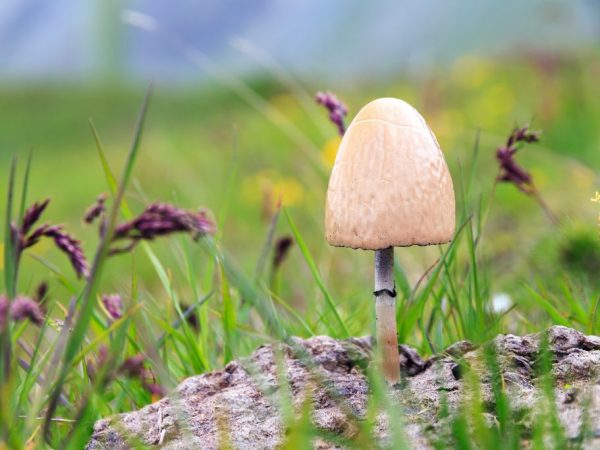

The mushroom is used for medicinal purposes
Dung beetle is an ordinary mushroom, but its chemical composition contains a substance that can have a destructive effect on the development of malignant neoplasms.
Treatment with medicinal preparations based on extracts is practiced for sarcoma. It has anti-inflammatory and antibacterial properties. Normalizes pressure in blood vessels, activates digestive processes.
Traditional medicine and pharmacology uses the mushroom to combat alcoholism. With the simultaneous use of fruit bodies with alcohol, it can cause poisoning.
The calorie content depends on the variety and varies from 15 to 22 kcal per 100 g. They contain about 3 g of proteins, less than 1 g of fat and about 3.5 g of carbohydrates.
Potential harm
Edible species have no contraindications, subject to the general daily intake recommended for common mushrooms.
It should be used with restrictions for people with heart disease.
Alcohol dung
Koprinus is a very effective and powerful remedy for alcoholism. It was once used by our great-grandmothers. At the present moment, medicine is officially recognized that the dung beetle mushroom helps to get rid of alcoholism. Today, it is the basis of some of the remedies for this addiction.
To prepare such an effective remedy, young mushrooms are collected that have not yet fully blossomed. Next, they need to be cooked as quickly as possible, since freshly picked mushrooms lose their appearance very quickly, becoming an ink-colored porridge.
Geography of distribution and collection time
All dung beetles belong to saprotrophs, which have the ability to destroy the dead remains of living organisms, transforming them into inorganic and simple organic compounds.
Therefore, the main growing places are located where there are nutrients:
- on dung heaps and humus;
- in decaying wood;
- on the remains of dead vegetation;
- in humus-rich soils.
They grow in large groups. Fruiting occurs in summer and autumn.
Collection and storage rules
It is necessary to look for koprinus near compost pits, garbage dumps and manure heaps, because they prefer soils rich in organic fertilizers.
Harvesting is worth in places far from industrial production and highways, because they quickly accumulate industrial toxins released into the environment.
Having found one mushroom, you should inspect the nearby area, because they usually grow as a family.
Preference should be given to young small specimens. An adult is suitable for harvesting within 2 days after the end of sporulation. After this time, autolysis processes are activated, during which, with the release of a special enzyme, self-destruction of the fruiting body occurs.
Such a mushroom looks like a melted one: it has a wrinkled cap, from its edges black drops that look like ink flow down.
Autolized fruiting bodies are not suitable for either culinary or medicinal purposes.
The harvested crop is immediately sent to its destination, because when stored, even in ideal artificial conditions, as in natural conditions, autolysis begins, and they become unusable within a few hours after collection.
You can extend the shelf life by putting them in the refrigerator.
How does it work?
Its action is associated with a toxic substance in it, which oxidizes the alcohol that enters the body. The substance, dissolving in alcohol, enters the bloodstream, then into the liver, thereby causing signs of serious poisoning.
A mushroom without a connection with alcohol is absolutely harmless. But if you eat mushrooms and drink alcohol after a while, serious consequences will appear:
- the main part of the body is covered with purple spots;
- the face turns red very much (even turns purple);
- the earlobes and tip of the nose turn pale;
- fever appears;
- the pulse quickens and the heartbeat begins;
- very intense thirst arises;
- vision is impaired;
- vomiting appears;
- speech deteriorates.
Of course, after a while, these symptoms disappear without a trace, but if you touch the glass again, they will return with renewed vigor. At the same time, the alcoholic attributes such terrible consequences to the action of alcohol, and this forever discourages him from drinking.


It is worth noting that the dung beetle mushroom from alcoholism acts for several days after its use, therefore, an alcoholic is unlikely to associate it with his current state.But in order to finally lull his vigilance, they mainly use a mushroom in powder, adding it to food.
Culinary technology
Only hats are suitable for eating.
The taste characteristics of the koprinus are reminiscent of champignons. For culinary purposes, only hats are suitable, mushroom legs are not used for.
Prepare immediately after collection, no later than 3 hours before the start of autolysis. They need to be washed, and then they can be fried or stewed for an hour. They are also suitable for making soups.
Cooking use
Due to the rapid lysis process, accompanied by the decomposition of the pulp, dung beetles are best collected young, not older than two days of age (until the plates have darkened), and cooked no later than an hour and a half after collection. They should not be mixed with any related species or other mushrooms.
Recommended Reading: The Volvo 480 is a hydraulic crawler excavator with unrivaled performance. In creating the model, the Swedish manufacturer was helped by many years of experience in the automotive field. As a result, the excavator received ...
After the initial boiling for 15-20 minutes, the water is drained, the dung beetles are fried, stewed, soups are cooked from them, and pickled. In addition, these mushrooms are dried after pre-frying in a pan.
Application in the treatment of alcoholism
On the basis of dung beetle, the pharmaceutical industry produces drugs against alcoholism. The average price is from 900 rubles.
You can make a remedy for drunkenness yourself at home. Preparation:
- the caps are thoroughly washed and dried over high heat for an hour without using oils;
- ready-made, which have become brittle and fragile, mushrooms are chopped in a blender;
- stored in a closed glass container.
If you intend to take the mushroom for medicinal purposes, you should first consult with your doctor.
Treatment procedure:
- the daily dose is 1 tsp;
- frequency - with an interval of 1 day;
- duration - 2 weeks, in advanced cases it increases, but not more than 3 months.
The technique consists in intoxication of the body when combining the fruiting body with alcohol.
Side effects can be chills, bouts of nausea and vomiting, heart palpitations, and dizziness.
Self-cultivation
White and gray varieties for medicinal and culinary purposes are grown independently on personal plots.
A shaded place with nutritious soil is suitable for home growing.
For the substrate, humus, fallen leaves, manure, straw and vegetable tops (but not tomato and potatoes) are used. The mycelium is sown in an even layer to a depth of 0.1 m, watered with a sprinkler method and sprinkled with soil.
The optimum temperature for active fruiting is about 30 ° C.
Fruiting begins 2-3 weeks after planting. Mycelium gives a mushroom harvest several times a season, when grown at home in boxes - all year round.

